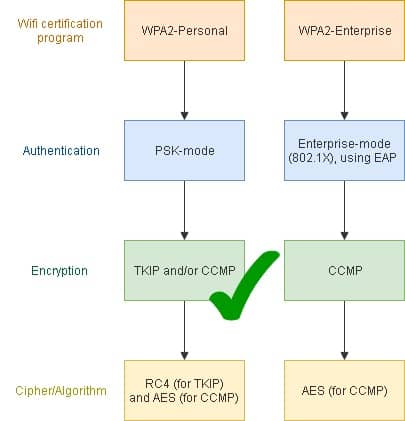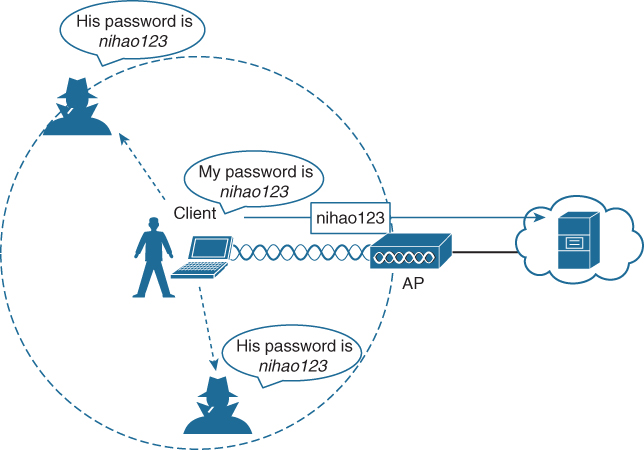Which Wireless Encryption Standard Uses Rc4 With Tkip
This version came up with the AES. AES stands for the advance encryption standard.
Encryption Chapter 8 Wireless Network Security Protecting Information Resources Wireless Networks First Step Networking Etutorials Org
First TKIP implements a key mixing function that combines the secret root key with the initialization vector before passing it to the RC4 initialization.

. -allows for mixing of root key with the IV initialization vector. WPA2 replaces RC4 and TKIP with two stronger encryption and authentication mechanisms. A new 80211n router will want to default to WPA2-AES encryption but if you go with WPA-TKIP instead your speeds will decrease significantly.
Unfortunately TKIP came with its own set of vulnerabilities and eventually it was deprecated from the 80211 standard. Which encryption standard uses Advanced Encryption Standard AES a 128-bit block cipher that is much tougher to crack than the 128-bit TKIP-RC4 wrapper. The terms WPA-TKIP or WPA-PSK are often used to refer to WPA-Personal or WPA-Personal.
It is a streaming cipher that works with key sizes between 40 and 2048 bits and it is used in SSL and TLS. It has a number of vulnerabilities that have prompted security experts to recommend against its use whenever possible 0 points Which wireless encryption standard is based on RC4 symmetric encryption and uses 64- or 128-bit encryption key. WPA2 uses CCMP to be able to encrypt the traffic going through our wireless networks.
Advanced Encryption Standard and Counter Mode with Cipher Block Chaining Message Authentication Code Protocol respectively. And TKIP did was every packet would be assigned a different key. TKIP is the encryption method used in Wi-Fi Protected Access WPA which replaced WEP in.
WPA-TKIP uses the RC4 cipher. The previous version of WPA used the RC4. TKIP was designed by the IEEE 80211i task group and the Wi-Fi Alliance as an interim solution to replace WEP without requiring the.
AES supports key sizes of 128 192 and 256 bits with 128 bits being the default. TKIP is the original encryption standard used on 80211 wireless networks. For personal use WPA2-Personal with AES only turn off anything that says TKIP is sufficient as long as you use a very long and hard to guess passphrase.
Difference between WPA and WPA2 is that the former implements most but not all of 80211i in order to be able to communicate with older wireless devices that might still need an update through their firmware in order to be compliantWPA uses the RC4 encryption algorithm with TKIP whereas WPA2 implements the full standard and is not compatible with older devices. Also the TKIP was replaced as well. Function that combines the secret root key with the initialization vector before passing it to the RC4 initialization.
80211i will change the WPA RC4 usage to employ AES. WPA used an encryption method called RC4 along with something called TKIP T-K-I-P that stands for temporal key integrity protocol. WPA2 uses AES-CCMP Encryption.
Advanced Encryption Standard AES has replaced DES as the current standard and it uses the Rijndael algorithm. TKIP and the related WPA standard implement three new security features to address security problems encountered in WEP protected networks. Referred to as WPA2 the main difference for regular user would be.
In addition to being outdated and unsecure TKIP is infamous for slowing systems that still use it. This encryption standard uses a 128-bit block cipher that is more difficult to crack than. The encryption protocol that became our long term solution for wireless security is WPA2.
A relatively small amount of bits in the world of encryption RC4 sometimes reuses the key. And so a work around was created called WPA. WPA-TKIP uses the RC4 cipher.
Hence it provided some more security to the data that was transmitted through one point to another. RC4 is popular with wireless and WEPWPA encryption. How was WPA improved over WEP -uses RC4 with TKIP -initialization vector is larger and an encrypted hash -every packet gets a unique 128 bit encryption key TKIP Temporal Key Integrity Protocol A security protocol created by the IEEE 80211i task group to replace WEP.
WPA uses as describe above TKIPMIC Encryption. The Big Change will be Advance Encryption Standard AES. Temporal Key Integrity Protocol TKIP tiːˈkɪp is a security protocol used in the IEEE 80211 wireless networking standard.
That stands for Wi-Fi protected access. In order to make deployment easier WPA-Personal supports what is called a Pre-Shared Key or PSK. Download scientific diagram Construction of TKIP based on RC4 stream cipher which uses long IV and encryptionauthentication keys.
Answer 1 of 3. 80211 is an IEEE standard that defines the protocol architecture of a wireless local area network. It works more effectively than the RC4.
It was designed to provide more secure encryption than the notoriously weak Wired Equivalent Privacy WEP the original WLAN security protocol. Instead of using RC4 as the encryption algorithm WPA2 use uses AES or the. First TKIP implements a key mixing.
Also meant to be backward-compatible WPA2 supports TKIP as a fallback if a device cannot support CCMP. Setting this up requires a. TKIP Temporal Key Integrity Protocol is an encryption protocol included as part of the IEEE 80211i standard for wireless LANs WLANs.
TKIP is primarily used for WPA-Personal now since it is based on the RC4 cipher rather than the assumed more secure AES. For corporations we recommend WPA2-Enterprise with EAP-TLS as the Authentication scheme. TKIP and the related WPA standard implement three new security features to address security problems encountered in WEP protected networks.

The Difference Between Wep Wpa And Wpa2 Msinfokom

Wi Fi Security Evolution How We Ended Up In Wpa3

Comments
Post a Comment